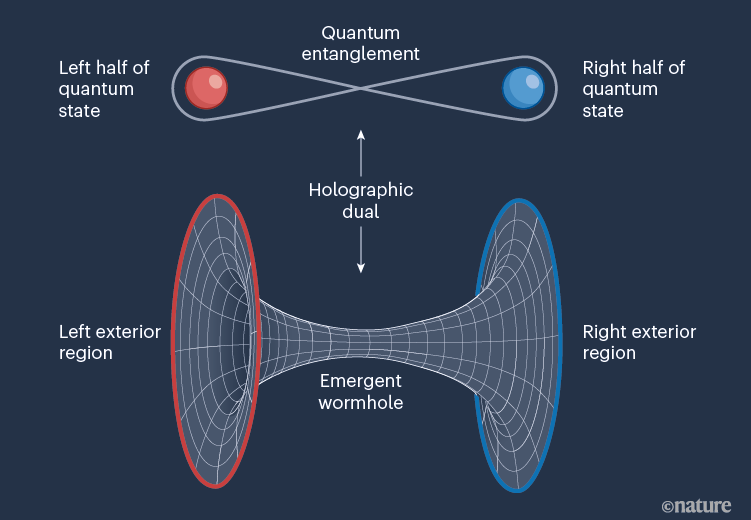By tunneling quantum bits via such a singularity, physicists have successfully produced the quantum physical equivalent of a wormhole in a quantum computer. This allows us to test the notion that an Einstein-Rosen bridge is equivalent to entanglement in quantum mechanics, one of the most basic linkages between gravitational wormholes and quantum theory. According to the Nature paper, this might shed light on some of physics’ most perplexing topics.
In principle, wormholes may connect two different points in space and time. In 1935, Albert Einstein and Nathan Rosen proposed that a black hole singularity may construct tunnel-like linkages between otherwise disconnected parts of space-time. It’s disputed, however, whether or not such an Einstein-Rosen bridge could be crossed in spite of the intense gravitational forces.

Connecting entanglement and spacetime geometry via quantum experiment
Recently, however, the wormhole idea has been extended to include quantum mechanics, which recasts spacetime tunnels in a whole new light. Particles or information at opposite ends of a tunnel can be said to be entangled (through quantum physical entanglement, or EPR), as suggested by the Einstein-Rosen (ER) bridge. For the first time, Einsteinian gravity is connected to quantum mechanics and the idea of quantum teleportation through a wormhole.
A holographic spacetime bridge
Previously only posited theoretically, researchers headed by Harvard’s Daniel Jafferis have now tested this link between a wormhole and teleportation. Harvard’s Maria Spiropulu, the paper’s principal author, reveals that they’ve uncovered a quantum system with the hallmarks of a gravitational wormhole that is nevertheless compact enough to be implemented on existing quantum technology.
The work builds on a 2017 quantum system created by Jafferis and two collaborators, which “translates” the gravitational properties of a conventional wormhole into a holographic quantum model with decreased dimensions. In 2019, Jafferis theoretically proved that two such so-called SYK systems that are quantum-physically entangled correspond to a passable Einstein-Rosen bridge.
Qubits through wormhole

This experiment relies on a wormhole model that was machine-learned down to its essentials so that it can be executed on Google’s Sycamore quantum computer. Nine quantum bits were used in a circuit with 164 two-qubit gates to build the entangled SYK systems. This simplified SYK model includes the essential physical elements of a passing wormhole, albeit in an approximative manner.
Specifically, it proved that the scientists’ sending of a qubit through the wormhole in quantum mechanics resulted in the same qubit’s appearance on the other side. The researchers looked at the sequence in which particles entered and exited the wormhole. The qubits should have reappeared behind the wormhole in the same sequence if ER=EPR is true and the SYK model faithfully reproduces the gravitational mechanics of an Einstein-Rosen bridge.
A baby step forward
Researchers believe this experiment represents a significant advance in testing basic concerns in current physics using quantum mechanics. Chief among them is the ongoing challenge of integrating quantum and particle physics with Einstein’s concept of gravity as spacetime curvature. One of the most pressing issues in basic physics is how quantum entanglement relates to spacetime and quantum gravity.
The scientists are thrilled to have the opportunity to try out these concepts using quantum technology for the first time in this experiment. They intend to use quantum computers to test the theory of quantum gravity, and this is the first step toward doing so. Advanced quantum computing hardware is already being developed by the researchers in order to map more realistic wormhole analogues.


